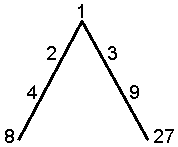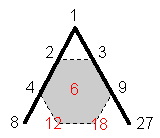
Figure 1. Plato's Lambda.
| << Previous 1 2 [3] 4 5 ...16 Next >> |
Plato's Lambda — historical background
In Timaeus, Plato’s treatise on
Pythagorean cosmology, the central character, Timaeus of Locri (possibly a real person), describes how the Demiurge divided the World Soul
into harmonic intervals. Having blended the three ingredients of the World Soul — Sameness, Difference and
Existence — into a kind of malleable stuff, the Demiurge took a strip of it and divided its length into portions
measured by the numbers forming two geometrical series of four
terms each: 1, 2, 4, 8 and 1, 3, 9, 27, generated by multiplying 1 by 2 and 3 (Fig. 1). This became known as "Plato’s Lambda" because of its resemblance to
Λ, the Greek letter lambda. Then, according to
Timaeus:
“he went on to fill up both the double and the triple intervals, cutting off yet more parts from the original
mixture and placing them between the terms, so that within each interval there were two means, the one (harmonic)*
exceeding the one extreme and being exceeded by the other by the same fraction of the extremes, the other
(arithmetic) exceeding the one extreme by the same number whereby it was exceeded by the other. These
links gave rise to intervals of 3/2 and 4/3
and 9/8 within the original intervals. And he went on to fill up all the intervals of 4/3 (i.e., fourths) with the
interval of 9/8 (the tone), leaving over in each a fraction. This remaining interval of the fraction had its terms
in the numerical proportion of 256 to 243 (semitone). By this time, the mixture from which he was cutting off these
portions was all used up.”
|
|
|
|
These numbers line but two sides of a tetractys array of ten numbers from whose relative proportions the musicians of ancient Greece worked out the frequencies of the notes of the now defunct Pythagorean musical scale.
 |
|
|
The three numbers missing from the Lambda are shown in red in Figure 2. The
sum of the 10 integers is 90 and the sum of the integers 1, 8 & 27 at
the corners of the tetractys is 36. The seven integers at the centre and corners of the grey hexagon shown
in Figure 2 with dashed edges add up to 54. Hence, the 36:54 division displayed by the Lambda
Tetractys differentiates between its corners, which correspond to the Supernal Triad of the Tree
of Life, and its seven hexagonal yods, which correspond to the seven Sephiroth
of Construction (see here). The division is shown by all holistic systems, as many of
the articles on this website prove. Historians of science and musical scholars have focussed upon the integers
as "number weights" whose significance is that their ratios are the tone ratios of the notes of the Pythagorean
musical scale. They paid no attention to the magnitude of the numbers themselves because,
influenced by the connotation given by Plato that their ratios determined the more important tone ratios, they
seemed to have no relevance to music or anything else. The author's research into various sacred geometries and
holistic systems indicates that this is untrue. The number 90 is always present in such systems as a defining
parameter, as this section will demonstrate. The Lambda Tetractys has been regarded as nothing more than a
heuristic device for generating the tone ratios of musical notes. Instead, it has profound, fundamental meaning,
for — together with its tetrahedral generalisation to be described shortly — it characterizes the very nature of
holistic systems. It is the arithmetic counterpart of the holistic pattern that sacred
geometries embody.
* H is the harmonic mean of two positive numbers a and b (b›a) if (b-H)/(H-a) = b/a. A is their arithmetic mean if (b-A)/(A-a) = 1.
| << Previous 1 2 [3] 4 5 ...16 Next >> |